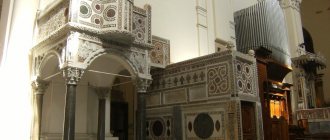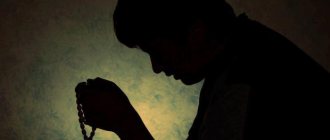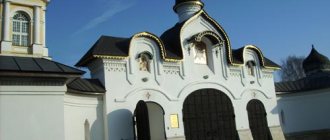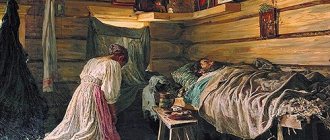The image and likeness of God in man
The theme of the image and likeness of God is one of the central ones in Christian anthropology. To a greater or lesser extent, all ancient church writers tried to reveal this topic. Plato also said that God “minted” living beings “according to the nature of the prototype.” And Philo of Alexandria called man “created in the image of an ideal prototype.”
We are not aware of any voluminous works devoted to this topic. However, many holy fathers paid due attention to it. This topic does not lose its relevance and usefulness in our time. The decline of morality and piety in society testifies to a person’s basic ignorance of what potential was built into him by the creator, what his purpose in the world is. This is precisely where Christian culture and Christian faith can help modern society, which, unlike all other ideologies and religions, clearly and clearly defines the role and place of man in the universe.
And in this work we will try to give a brief outline of what the holy fathers meant by the terms “image” and “likeness” of God in man.
The Greek word for "image" (eikon - hence "icon") means "portrait" or "image", i.e. something created according to a model and resembling the image, although not identical to the latter in nature (5:68). The sacred writer narrates about the creation of man: “And God said: Let us create man in our image and likeness... And God created man, in the image of God created him: husband and wife created he them” (Gen. I, 26-27).
What is the image of God in us? Church teaching only instills in us that man is generally created “in the image,” but it does not indicate which part of our nature reveals this image. The fathers and teachers of the Church answered this question differently: some saw it in reason, others in free will, and still others in immortality. If you combine their thoughts, you get a complete picture of what the image of God in man is, according to the instructions of St. Fathers (6;83).
But, first of all, the image of God must be seen only in the soul, and not in the body. God, by His nature, is the Pure Spirit, and not clothed with any body and not involved in any substance. Therefore, the concept of the image of God can only relate to the immaterial soul: many Fathers of the Church consider it necessary to make this warning (6:83).
Man bears the image of God in the highest properties of the soul, especially in its immortality, in free will, in reason, in the ability for pure selfless love. Here is what St. writes about this. Gregory of Nyssa: “Divine beauty is not in external features, not in the pleasant set of the face and does not shine with any kind of good color, but is seen in the inexpressible bliss of virtue... As painters represent human faces in a picture with paints, erasing for this purpose such colors of paint that are close and accordingly they express the likeness so that the beauty of the original is accurately depicted in the copy, so imagine that our Creator, as if by superimposing some colors, i.e. virtues, he colored the image to the likeness with his own beauty, in order to show his own superiority in us. These are the colors of the image with which he paints the true image... - purity, dispassion, bliss, alienation from everything bad, and everything is homogeneous with this, which depicts the likeness of the Divine in man. He painted our nature with such colors of His own image” (2:7). And according to St. Gregory Palamas, man is more in the image of God than the angels, because his spirit, united with the body, has a life-giving power, with which he animates his body and controls it. This is an ability that angels, incorporeal spirits, do not have (7;212).
So, man appears before us as a miniature reflection of God on earth (4:63). In the "Sex Day" of St. Basil the Great develops in detail his teaching about the image of God in man. In this teaching, man appears as a geocentric being, whose entire being is designed to reflect the divine life, and who is created in the image and likeness of God. At the same time, man is a “microcosm”; he, as it were, collects, generalizes (in patristic terminology, recapitulates) within himself the entire created world, the center and crown of which he is called to be (8:157).
Now let's look in more detail at what properties of the soul, according to the teachings of the Holy Fathers, are the image (or, more correctly, reflect) God in man.
Features of the image of God St. The fathers saw in the rational-spiritual nature of man as a “reasonable being.” “Our mind... is related to God, it serves as a mental image of Him,” says Origen. “We are created in the image of the Creator, we have reason and speech, which constitute the perfection of our nature,” writes St. Basil the Great (5;68). St. writes about the same thing. Gregory of Nyssa: “Divinity is the mind and the word, for “in the beginning was the word” (John 1:1) and the prophets, according to Paul, have the mind of Christ (1 Cor. 2:16), speaking in them (2 Cor. 13, 3). Human nature is not far from this. You see in yourself both the word and the mind, the likeness of the true Mind and the Word” (2:6). The mind of a person makes his will conscious and truly free, because he can choose for himself not what his lower nature attracts, but what corresponds to his highest dignity. Therefore, the next thing in which the Holy Fathers see the image of God in man is free will and the ability to choose. God created man absolutely free: out of His love. He does not want to force him to either good or evil. God is an absolutely free and infinitely perfect being, and man is free in the choice and direction of his actions, and the highest goal of human activity is the pursuit of perfection (4;63).
Only being free can a person become like God through love for Him. St. Gregory of Nyssa said: “God is also love and the source of love,” the great John says: “Loves are from God, and God is loved” (1 John 4.7,8). The Creator has made this a distinctive feature of our nature. For he says: “By this they all understand that you are my disciples, if you have love for one another” (John 13:35). Consequently, where this love does not exist, all the features of the image are transformed there” (2:7).
God is an Eternal Being and our soul is immortal, for the spiritual is indestructible through the continuation of existence. Thus, Tatian calls man “the image of the immortality of God.” In addition to immortality, they also talk about the dominant position of man in nature, about his inherent desire for good as features of the image of God. St. Macarius the Great says that God created the soul “in the image of the virtue of the Spirit, putting into it the laws of virtues, prudence, knowledge, prudence, faith, love and other virtues, in the image of the Spirit” (5:69).
And finally, a person’s ability to be creative is a reflection of the creative ability of the Creator himself. God is a “worker”: “My Father is working until now, and I am working,” says Christ (John 5:7). Man is also commanded to “cultivate” paradise (Gen. 2:15), i.e. to work in it, to process it. Man cannot create ex nihilo (“out of nothing”), but he can create from the material created by the Creator.
Is there a difference between the image and likeness of God? Some combine these two concepts into one, as for example, we saw in St. Gregory of Nyssa. And some St. The Fathers distinguish “image” from “likeness,” noting that image is what was originally put into man by the Creator, and likeness is what was to be achieved as a result of a virtuous life: “the expression “in the image” means rational and endowed with free will , and the expression “in likeness” means likening through virtue, as far as possible” (St. John of Damascus). A person must realize all his abilities in the “cultivation” of the world, in creativity, in virtue, in love, in order to become like God through this, for “the limits of a virtuous life are likeness to God,” as St. Gregory of Nyssa (5;69).
To summarize our work, we note once again that by the image of God we understand the mind, free will, love and immortality given to us by God. And by the likeness of God we must understand a person’s ability to direct the forces of his soul to become like God - to improve in the pursuit of truth and goodness (9:136).
In people one can see a single nature and a plurality of persons. Philosophers call man a microcosm, as the image and likeness of the universe, but this is not his height and beauty, but that he is a participant in the Divine fullness. Man is responsible for the cosmos, for the deification of all creation. Freely in love, a person chooses good and merges his will with the will of God, for in the union of wills there is deification.
Literature:
Bible. Books of the Holy Scriptures of the Old and New Testaments. Moscow: Russian Bible Society, 2000. St. Gregory of Nyssa. Man is the image of God. M., 1995-32p. St. Basil the Great. Conversations for six days. Moscow: publishing house of the Moscow courtyard of the Holy Trinity Sergius Lavra, 2001-260p. Theology. Experience in clarifying the vital meaning of the truths of the Christian Orthodox faith. Vilnius: Holy Spirit Monastery, 1991. Hieromonk Hilarion (Alfeev). The mystery of faith. Introduction to Orthodox dogmatic theology. Moscow-Klin: publishing house of the Brotherhood of St. Tikhona, 1996-288p. Protopresbyter Mikhail Pomazansky. Orthodox dogmatic theology. Novosibirsk: Blagovest, 1993-240 p. Man is the temple of God. Kolomna, 1995-223p. Archpriest John Meyendorff. Introduction to Patristic Theology. Lecture notes. Minsk: Rays of Sofia, 2001-384p. God's Law. St. Petersburg: Brotherhood of the New Martyr Archbishop Hilarion of Vereisky, 2000-723 pp.
Author of the article: Alexey Bogorodtsev
How to pray in front of an icon
Many people think that it doesn’t matter which icon to pray in front of, because prayer comes from a pure heart. But we offer a prayer not to the icon itself, but to the one whose image is conveyed on it, because all saints have their own strengths.
- Stand in front of the shrine and cross yourself to attract God's blessing.
- After you have asked for help, that is, prayed, kiss the image. By doing this you will express your respect to the Lord.
- After finishing the prayer service, you must cross yourself three times.
Pray with bright thoughts, forgiving everyone who offended you.
See also on the blog: How to light candles
The meaning of the icons
Semistrelnaya
This is one of the most powerful icons. The Most Holy Theotokos had to endure many torments, which are symbolized by seven arrows. When a person feels bad, he goes precisely to this image. “Seven Shot” will help in protecting housing, will protect from troubles, envious, evil people, from curses, damage, the evil eye of the person who wears her icon on his chest.
If you need to reconcile the warring parties, bring peace and tranquility to your home, then you need to kneel before this relic and prayerfully ask for help. They take it with them when they go on important matters.
At home, she is placed opposite the front door, higher than half the wall, so that she can “see” the eyes of the person entering. Before installing the relic, it is necessary to read a prayer service. You may notice: a person with unkind thoughts will stop crossing the threshold of your home.
The Most Holy Theotokos will become a protector from criminals, thieves and any unkind people. Those living in this house can be sure that their family is reliably protected.
Place it on your desktop, it will protect you from quarrels with your boss and work colleagues. If a person’s soul is embittered, then he can approach the face, the Most Holy Theotokos will help him return to good thoughts again.
"INEXHAIBLE CHALICE"
Icon of the Mother of God. The Mother of God consoles, prays for everyone who has stumbled, and calls upon them to touch the inexhaustible spring of spiritual joy. The purpose of this holy power is difficult to overestimate.
The inexhaustible cup will help everyone who turns to it with faith. She proclaims that heavenly help and mercy are destined for all who ask. It will help cure those who are addicted to gambling from drunkenness, drug addiction.
The image of the Mother of God should be installed at the head of the bed of a patient with alcoholism or drug addiction and prayed every day.
There are many known cases of healing from drunkenness and other addictions. There is evidence that the relic helped solve housing issues and facilitate the conclusion of transactions for the purchase and sale of apartments and houses.
Parents who send their children into adulthood are obliged to ask for help by saying prayers in front of the shrine every day.






